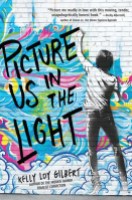Congratulations to the 2019 Stonewall Book Award winners and honors!
Here are the books that received recognition (with links to our coverage):
Winners: Hurricane Child by Kheryn Callender and Julián Is a Mermaid by Jessica Love.
Honors: Picture Us in the Light by Kelly Loy Gilbert and Ivy Aberdeen’s Letter to the World by Ashley Herring Blake.
Two of these titles were selected in our mock award—not bad!
We’re excited to see Hurricane Child, Picture Us in the Light, and Ivy Aberdeen take the award; they’re books we raved about along the way! It’s especially wonderful to see two middle grade books about queer girls receive attention. This recognition represents something new—and much-needed—for the award.
We’re uneasy about Julián‘s win given the concerns that have been raised about it. See: “Trans People Aren’t Imaginary Creatures” (Booktoss) and Alex Gino’s recent tweets.
Looking beyond the Stonewall, there were other exciting wins for queer books:
- Jerome by Heart by Thomas Scotto with illustrations by Olivier Tallec (translated by Claudia Bedrick and Karin Snelson) received a Batchelder Award honor
- Anger Is a Gift by Mark Oshiro won in the Schneider Family Book Award’s teen category
- Darius the Great Is Not Okay by Adib Khorran won the Morris Award AND won in the Asian/Pacific American Award for Literature’s young adult category
- My Brother’s Husband Vol. 1 & 2 by Gengoroh Tagame (translated by Anne Ishii) won the inaugural GLLI Translated YA Book Prize
GLBTRT’s 2019 Rainbow Book List has been announced, too! Two of our mock picks (Hurricane Child & Darius the Great) made the Top Ten!
And so we wrap up the award season with plenty to celebrate and plenty of gratitude toward those who commented, guest blogged, or lurked at the blog this season. We’ll be back in the summer in anticipation of the 2020 awards! In the mean time, drop us a line if you’re interested in guest blogging.
Edited 2/6/19: We’ve removed a portion of this post reacting to what we interpreted as a mislabeling of Hurricane Child as YA in the awarding process. Our interpretation was based on language that was used in ALA’s press release. We’ve since learned that this language did not accurately reflect the committee’s decision.





Clarification: There are not two categories in Stonewall youth. Hurricane Child did not win in an imaginary teen category. We were aware and recognized it as middle grade. As for Julian, we knew about at least some of the issues surrounding it. I can’t go into specifics of what happened during deliberations, obviously, but decisions were not made ignorantly.
LikeLiked by 2 people
Thank you for the clarification about Hurricane Child. We were responding to language used in ALA’s press release, where the two books were described as “recipients of the Stonewall Book Awards – Mike Morgan & Larry Romans Children’s & Young Adult Literature Award, respectively,” which implied to us a children’s/YA distinction. We have no interest in misrepresenting the committee’s decision, and we’ll update this post accordingly.
In our (admittedly blunt) assessment of Julian’s awarding, our goal wasn’t to criticize the committee but to question the impact of the award decision. The celebration of an award winning book can do a lot to eclipse dissenting opinions. We wanted to bring those voices back to the fore because they’re a vital part of the conversation. We hope we can raise questions about impact without the perception that we’re disparaging the intent of the committee or attempting to diminish the committee’s hard work.
All of us here appreciate the tremendous amount of labor, thought, and care that goes into the difficult process of award decisions. Thank you — and the committee as a whole — for your service.
LikeLike
Here are some appreciations by one of my colleagues, librarian
Jamila Zahra Felton/@beatofblossoms
I wanted to highlight some points about Julián is a Mermaid that seem to be missing from how some people critique the book.
* It is Black and Afro-Latinx affirming.
* Black and Afro-Latinx women and girls are central.
* It is Queer and Trans affirming, even though we do not know how Julián identifies.
* It has Black joy, Black beauty, and Black love at its core.
* It is body positive, age positive, and family-structure positive.
* Yes, it is not an #OwnVoice text.
* But, Julián is a Mermaid can do at storytime and bedtime and circle time and in the therapist/counselor/social worker’s office what no other book can currently do right now.
* I am a Black woman. I am cisgendered and heterosexual. I am a K-8 librarian, educator, artist, writer, and mother.
*What currently published, picture book do I read with my son or my students to talk about the love and joy and affirmation we have for Black and Afro-Latinx individuals who may be gender non-conforming or LGBTQIA?
With peace,
Jamila Zahra Felton
✊🏾👏🏾🤲🏾🙏🏾💕
Speaking for myself, I am disturbed by conversations around Julian is a Mermaid. From the Twitter thread to Dr. Jimenez’s post on BookToss there is the framework that is important to think about in terms of gender-play and the assumption of a trans-experience and that is fair. But developmentally, given the age of Julian, and the intended audience, questioning of gender identity and sexual identity look different seems developmentally on point. If we frame the criteria for the award and recognition as inclusive of the pantheon of LGBTQIAP+, doesn’t this fit into the body of literature? People disagree all the time with the winner of an award, and they all have a right to their opinions and a right to disagree with the committee. I just want to see more consideration from all points of view.
As a ciswoman who does not identify as queer, I understand that my point of view is not own voices, and I don’t want to drown out voices that object on the basis of trans representation and the perception that straight people are fascinated or fetishize trans bodies. But critiques of the book say “beautiful” without specifically looking at Black joy and beauty that is celebrated and the validation that it gave to people who saw themselves, their communities and the value of a book that does not center Black, Brown and queer (and intersections therein!) trauma.
Frankly, these reviews lack self-examination of the sexualization of Black bodies and Black children (and who is hyping that sexualization), and is also problematic. Does objectification of Black bodies mean that we could never have a child of color be a protagonist of a book with nudity like In the Night Kitchen? Perhaps that is too extreme or simplistic, but I think the discussion around this book also feels a bit flat.
I am disturbed by the erasure of Julian as a Black child and, in the discussion of the book, I am surprised that there is not a lot of representation by Black and Brown readers, specifically I don’t see Julian discussed as a Black child. There is one mention of Julian as Afro-Carribean, by another commenter on Dr. Jimenez’s post, two mentions of Dominican librarians and no others even though Black Latinxs exist outside of the DR and the diaspora. De colores also mentions Julian in the context of a Latinx child, but not as a Black child. Black readers may not be reading the same exposure and sexualization of a Black boy that queer (white) readers are. This is not saying that they are wrong, but I wish that the conversation was more nuanced and intersectional. There is no recognition of Black joy, beauty, and affirmation. Though I admire Dr. Jiminez and Angie, here I have to disagree or at least voice my concern. Especially when it comes to the frankly insulting connotations of Julian’s abuela being a mammy when she has agency and is a fleshed-out character. This mirrors the conversation that was had around Ezra Jack Keats and A Snowy Day, a book that still resonates with the Black community despite not being own voices, but did have a place in creating space for people of color, different bodies, and urban settings.
Jamila’s points articulate concisely and precisely the value that this book brings. She also talked about the little big things that are highlighted in this book – swimming and reading together. Teaching for Change highlights Julian on two of its booklists and is included in the booklist for National Black Lives Matter at School Week of Action. In the last few years, educators have talked about changes in curriculum and how damaging unnecessary trauma is on Black students – like teaching To Kill a Mockingbird. What does continually elevating traumatic books about people of color tell readers about how their stories are valued? Does this correlate with increased negative feelings about literature? What would have been the benefit in having abuela giving Julian angry looks and threatening to kick out this child out of her house?
The most profound question and point that Jamila brought up was, “in art and in book publishing, what might the artwork/book by a White ally look like? We need White allies to do anti-racist work, we can’t tell each White artist/writer who may also be an ally to NOT put Black joy at the center of their work.”
I am not Black but I am a Muslim bi-cultural Asian woman of color who sees erasure of the Black Muslims, erasure of Black identity of bicultural Asians and the colorism/internalized colonialism that has marginalized a continent, a people and the complexities of existing and being in a forced diaspora. I hope that discussion gets to be rich and nuanced and that more queer IPOCs get to be in the room and in the discussion.
Elevating the queer experience without acknowledging race and the nuances therein is elevating white queer experience and ultimately white supremacy. It erases the racist experiences and marginalized experiences that queer people of color face. Personally, I have been disturbed and saddened to see some books being held up that have erased or mislabeled IPOCs, or are outright offensive and racist, though in terms of queer representation they are notable. What does this tell me as a reader of color? What does this say about the communities queer IPOCs may hope to be a part of?
I am disheartened and frankly, angry by the mislabeling of Hurricane Child as a Stonewall winner in YA. It is irresponsible to say that Stonewall recognized Hurricane Child as a young adult book and not cite your sources. If the implication is that all Stonewall Book Awards – Mike Morgan & Larry Romans Children’s & Young Adult Literature Award books fall into the YA category, then why wasn’t the same question asked of Julian or Ivy. If this is assuming that this was the case because there were two winners this year, why wasn’t this also assumed/examined of last year’s winners? Two of our members this year were people of color, seven self-identify as queer. We are intelligent people who recognize quality work and queer/IPOC intersectionality. Please check yourself before making assertions about intentions and misidentification. Yes, we collectively chose Julian but we also chose Hurricane Child, if Gino is right about anything, please do elevate Callender’s book for the award-winning title that it is.
LikeLike